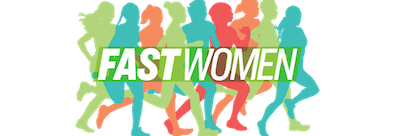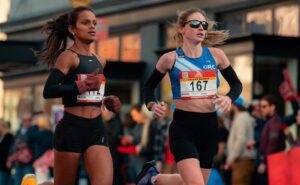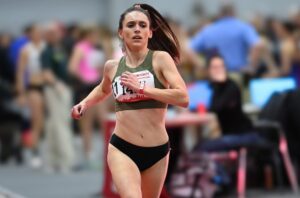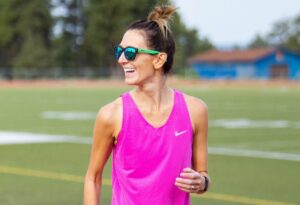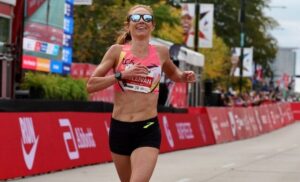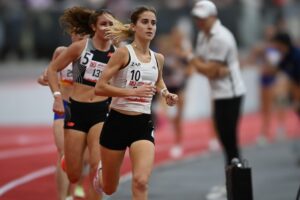I did some things right during my 13+ years as a high school and college coach, but I also did quite a few things wrong. One of the areas I had the most room for improvement was in how I handled most things related to what we now know as Relative Energy Deficiency in Sport (RED-S, pronounced “reds”).
I went into coaching roughly 18 years ago, pretty well educated on the topic, for the time. But despite coming from a place of awareness, I still didn’t always voice my concerns about eating disorders and RED-S well. I understand why many coaches struggle with it; it’s not an easy topic, and nothing in my many hours of coaching education prepared me for it.
Having been a part of 10 different cross country and/or track & field teams as an athlete or coach, and having known people who were part of countless other programs, I know that eating disorder issues are widespread within collegiate teams. Here’s what I would do differently now, based on what I’ve learned:
I would always proactively discuss eating disorders and RED-S with the entire team
At times, I feared that some of the discussion might make an eating disorder seem like an appealing shortcut to success, so I sometimes addressed my concerns on a case-by-case basis. In doing so, I missed people who needed to hear the same messages. There will be obvious eating disorder and RED-S issues on almost all teams, but a fair amount of it can be more subtle and harder to detect. Knowing what I know now, I would always bring the subject up proactively with the entire team, in an age- and gender-appropriate manner.
In a recent discussion with Kara Bazzi, a former Division I runner and co-founder of Opal: Food+Body Wisdom, she pointed out that silence will only lead to athletes to jump to their own conclusions about where a coach stands on the topic. Bazzi recommends that coaches don’t go too far outside their role; for example, nutrition should be left to a professional. But coaches can give athletes some of the basics, like emphasizing that adequate nutrition, eating frequently, and consuming protein, fats, and carbohydrates are all important. And if student-athletes have further questions, they can explore those with a professional, preferably a dietitian who specializes in eating disorders and athletics.
Bazzi says it’s okay to acknowledge that eating disorders might temporarily lead to improved performance, but it’s important to pair that with the information that it will not last very long, and what the long-term consequences of inadequate nutrition are.
“Once you have the felt experience of losing weight and getting better, that felt experience is far more powerful than knowledge and words and people saying, ‘Well you’re going to eventually crash,’ because it’s experiential and it’s really seductive,” Bazzi says. “If you can catch an athlete before they’ve done that, you’re far more likely to have them not go down that path.”
At one of the schools at which I worked, a professional spoke with the team privately, and coaches weren’t allowed in, so that the athletes would feel comfortable asking anything they wanted to know. If I could do that over, I would find out more information about the messages the professional was sharing, so I could work to fill in any gaps, and do a better job of following up on the issues that were addressed.
I would talk to the women and girls about puberty
Bazzi recommends sharing the message that weight gain is to be expected during puberty, and she says that the average weight gain is around 40 pounds. She said coaches can talk about the importance of putting on fat, acknowledging that it will shift the way athletes are moving and feeling in their bodies. Bazzi says coaches can say things like, “This is an exciting thing your body is going through, and it’s meant to be. Let’s see how that shift and those changes, how that interacts with your athlete side. Let’s work with it and not fight against it, because it’s really important that your body is doing it.”
Coaches can emphasize that attempting to fight puberty is a shortsighted approach, which will not lead to the best performance in the long term. And as Lauren Fleshman pointed out in her recent New York Times opinion piece, “It is grown women, not girls, who top the most prestigious podiums. It is grown women in their late 20s and 30s breaking American records. It is American women in their mid-30s winning the Boston and New York marathons. Imagine if we gave more girls a chance to get there.”
I would have a proactive plan in place
Instead of waiting to discover eating disorder and RED-S cases, I would assume they’re going to exist and have a proactive plan in place for how to handle them. That includes having a plan for how to intervene, and knowing exactly which professionals could help on campus or within the local community, and having tiers of options depending on the resources available at the school (since I know resources are very limited in certain communities and programs). I would also ask about how such things are handled and what resources are available during the job interview.
At several schools where I worked, the established protocol was for all such cases to be referred to the athletic trainers. In some situations, that might be a satisfactory route. But in a couple of cases, the athletic trainers were not equipped to handle such things. If I could go back, I’d do more digging to find out what resources were available to the entire student body, and see if there were additional on-campus resources that the student-athlete could use. If the school did not have any such resources, I would look for what’s available within the community, or via telehealth.
I would always intervene right away when I suspected an eating disorder
When I look back on my coaching experience, the thing I regret most is that I did not always intervene immediately when I suspected an eating disorder. I had a long list of excuses. They included:
- Wanting to be sure before intervening
- Being certain that the athlete would be in denial
- Having a head coach tell me they had already handled it and it was under control. In some of these cases, it was apparent it wasn’t, but I felt there was a limit to how much I could contradict my boss. In retrospect, I’d speak up (ideally by convincing the head coaches rather than contradicting them), no matter the cost. I trusted other people to be the experts because they had more years of experience, even when I knew I shouldn’t.
- Not wanting to step on someone else’s toes (like intervening during the track season when I was only an assistant cross country coach).
- Sometimes I didn’t intervene soon enough because the athlete was running so well. “Someone can be ill and performing well because, as we know, there’s usually increased performance with inadequate eating initially, temporarily, then some of the RED-S symptoms really start to show up,” Bazzi told me. It’s not easy to put the breaks on when an athlete is winning, having the best season of their life, and appears to be getting away with their detrimental habits. But it’s important.
It’s surprisingly easy to make excuses and avoid the conflict, but within a team, nothing is more important than the physical and mental health of the student-athletes. And when it comes to eating disorders, early intervention is important.
I would intervene differently
When I did intervene, I didn’t always do it well. Bazzi recommends having such conversations in a private location, when you’re not rushed, and she says curiosity is key in not eliciting defensiveness.
“You might state some observables,” Bazzi says. “‘I’ve been noticing that X, Y, and Z are happening. What’s that about? How are you doing? I’ve been wondering about you and am kind of concerned.’” (X, Y, and Z might be any of the items from the list at the bottom of this piece.)
She says if the student-athlete is prickly and defensive, that might be a sign that you’ve hit on something that is true. If they deny it, the door has at least been opened, and you can always try again later. If they do open up, having a next step ready is important, whether that’s asking how to support them, what it means for their experience on the team, or asking whether they’re open to receiving help.
Bazzi says that if you’re really worried about the athlete’s health, that’s when you might need to wield your power as a coach and set participation boundaries, ideally with the support of medical professionals.
I would model the behavior I wanted to see
It doesn’t matter what kind of messages you are trying to convey if your actions send a different message. Bazzi says that coaches need to look at their own beliefs and biases around food, weight, and performance, and understand where they’re coming from. If a coach says eating protein, fat, and carbs is important, but follows a low-carb diet, that sends a message.
I would also look to team members to model the same kind of behavior. If the top runners on the team bring their own food to meals or refuse to eat at the same restaurants as the rest of the team, their teammates will likely get the subtle message that that’s what it takes to be successful.
In this episode of her podcast (around the 34:00 mark), Olympian Carrie Tollefson talks about being recruited by Villanova coach Gina Procaccio, who was a reigning U.S. 5,000m champion at the time. All these years later, Tollefson still remembers Procaccio eating a hearty meal during her recruiting process. “I remember thinking, ‘Oh my gosh, if my coach eats like that and she runs [that fast], that’s who I want to coach me.”
I wouldn’t make disparaging remarks about my own body, and I would do my best to avoid comments that suggest that certain foods are bad or good. (I’ve been working on this lately in general, and it’s harder than I would have expected, especially when talking to kids.) Bazzi points out that athletes can take information out of context and run with it. Bazzi says a safer approach is to work on developing body knowledge and understanding how certain foods make one’s body feel and perform.
I would be more aware and concerned about eating disorders in people with bodies of all sizes, as well as in men
Bazzi says that eating disorders don’t discriminate with body shape, so someone could be in a “normal” or larger sized body and be very ill. Regardless of body size, Bazzi says some of the signs to look out for include:
- Weight loss or gain
- Preoccupation with food
- Compulsive training, including putting oneself in dangerous situations to get in training
- Training more than the coaches recommend
- Avoiding food-related social activities
- Strange eating behaviors
- Difficulty completing workouts (though this could be attributed to any number of things)
- Anxiety when they can’t practice
- Avoiding dressing in front of people
- Resistance if there is a recommendation for weight restoration
- Negative body comments
- Secretly eating, hiding, or stealing food
- Social withdrawal from teammates
- Frequently weighing oneself
- Avoiding water or excessive water intake
Since Mary Cain came out with her New York Times Op-Ed in November, I’ve seen quite a few coaches discussing what they do within their teams to avoid eating disorders and RED-S. Some of them have made comments that suggest they have it all figured out and don’t have any issues on their team. While that’s possible, it’s statistically unlikely, especially when dealing with distance runners.
If I could go back, or if I ever coach teams again, I will be more prepared. And in the meantime, I hope that each organization that hands out coaching certifications in this country is working to build more of this kind of information into their coaching education.

